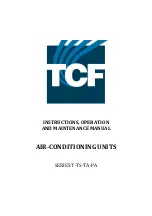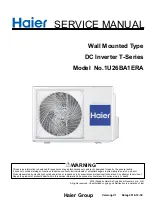
5
Safety Precautions
Due to our policy of continuous product innovation, some specifications may change without notification.
©LG Electronics U.S.A., Inc., Englewood Cliffs, NJ. All rights reserved. “LG” is a registered trademark of LG Corp.
SAFETY PRECAUTIONS
Be very careful when transporting the product. There is a risk of the product falling and causing physical injury.
• Use appropriate moving equipment to transport each frame; ensure the equipment is capable of supporting the weights listed.
• Some products use polypropylene bands for packaging.
Do not use polypropylene bands to lift the unit.
• Suspend the outdoor unit from the base at specified positions (at a minimum of six [6] points) to avoid slippage from rigging apparatus.
LG Electronics U.S.A., Inc., is not responsible for any piping
calculations, refrigerant leaks, degradation of performance,
or any other potential problems or damages as a result of
interconnecting piping, their joint connections, isolation
valves, introduced debris inside the piping system, or other
problems caused by the interconnecting piping system.
Do not install the product where it is exposed directly to
ocean winds.
Sea salt in the air may cause the product to corrode. Corrosion,
particularly on the condenser and evaporator fins, could cause product
malfunction or inefficient operation.
When installing the outdoor unit in a low-lying area, or a lo-
cation that is not level, use a raised concrete pad or concrete
blocks to provide a solid, level foundation.
This prevents water damage and abnormal vibration.
Properly insulate all cold surfaces to prevent “sweating.”
Cold surfaces such as uninsulated piping can generate condensate that
may drip and cause a slippery surface condition and / or water damage
to walls.
Always check for system refrigerant leaks after the unit has
been installed or serviced.
Low refrigerant levels may cause product failure.
Do not make refrigerant substitutions. Use R410A only.
If a different refrigerant is used, or air mixes with original refrigerant, the
unit will malfunction and damage will occur.
Do not store or use flammable gas / combustibles near
the unit.
There is a risk of product failure.
Do not use the product for mission critical or special pur-
pose applications such as preserving foods, works of art, or
other precision air conditioning applications. The equipment
is designed to provide comfort cooling and heating.
There is risk of property damage.
Keep the unit upright during installation to avoid vibration or
water leakage.
When installing the unit in a hospital, mechanical room, or
similar electromagnetic field (EMF) sensitive environment,
provide sufficient protection against electrical noise.
Inverter equipment, power generators, high-frequency medical equip-
ment or radio communication equipment may cause the air conditioner
to operate improperly. The unit may also affect such equipment by
creating electrical noise that disturbs medical treatment or image broad-
casting.
The heat recovery box must be installed indoors;
do not
install the heat recovery box in a highly humid environment.
There is risk of product failure and property damage.
When connecting refrigerant piping, remember to allow for
pipe expansion.
Improper piping installation may cause system malfunction.
Do not install the outdoor unit or heat recovery unit in a
noise-sensitive area.
Take appropriate actions at the end of HVAC equipment life
to recover, recycle, reclaim, or destroy R410A refrigerant
according to applicable U.S. Environmental Protection
Agency (EPA) rules.
Periodically check that the outdoor frame is not damaged.
There is a risk of equipment damage.
Install the unit in a safe location where no one can step on or
fall onto it.
Do not install the unit on a defective stand.
There is a risk of unit and property damage.
Install the drain hose to ensure adequate drainage.
There is a risk of water leakage and property damage.
CAUTION
WARNING
Properly insulate all cold surfaces to prevent “sweating.”
Cold surfaces such as uninsulated piping can generate condensate that could drip, causing a slippery surface that creates a risk of slipping, falling,
and personal injury.






































